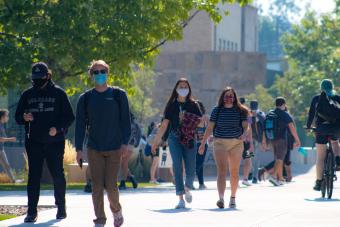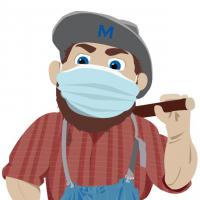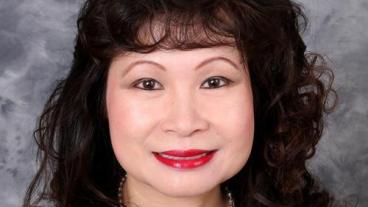Five ways Mines researchers and their students are making campus safer during the pandemic

What’s happening:
-
Metallurgists are testing copper mesh mask inserts as a way to attract and trap the virus.
-
Environmental engineers are analyzing wastewater, hoping to find cases before symptoms, or a positive test result, emerge.
-
Mathematicians are looking for transmission patterns and hoping to identify an optimal testing approach.
-
New HVAC best practices were implemented this summer. Researchers are now testing to see if they worked—and could work better.
-
Others are rapid-testing door handles, and other high-contact surfaces, to help adapt sanitation practices to best suit the Mines campus.
By Sarah Kuta, Special to Mines Newsroom
In August 2020, with the start of the fall semester looming and no end in sight for the coronavirus pandemic, Mines asked its research community for help.
The request? New projects — big and small — that could help make the campus safer for students, faculty and staff.
Mines researchers didn’t hesitate. Across campus, they rose to the challenge and quickly submitted their ideas, which included everything from wastewater testing to mathematical modeling.
“It was a great moment for us to see the variety of things people thought of and the excitement that this seemed to engender, that ‘Oh my gosh, we have a chance to help. Here’s what we can do,’ feeling,” said Stefanie Tompkins, vice president for research and technology transfer.
Mines doesn’t have a medical school — it’s not likely to develop a COVID-19 vaccine. But it does have hundreds of world-class experts in fields ranging from metallurgy to chemistry who can help do their part to solve this global crisis.
In the end, Mines’ research office is providing roughly $120,000 for five proposals across an array of disciplines. Already, the projects are helping campus leaders make real-time decisions that improve the safety and well-being of the Mines community.
We sat down with the researchers working on these projects to learn more.
Wastewater analysis
Once infected with the novel coronavirus, people can shed — and spread — particles containing the virus when they cough and sneeze. But they also shed the virus in their feces, which gets flushed down the toilet and ends up in the sewer.
At Mines, researchers are using this wastewater to help track the prevalence and spread of the disease on campus.
The project is led by Nicole Masters ’19, now a doctoral student in environmental engineering, along with John Spear, professor of civil and environmental engineering and director of Mines’ quantitative biosciences and engineering program, PhD student Rudy Maltos, and Tzahi Cath, professor of civil and environmental engineering and director of the Advanced Water Technology Center.
Using an instrument called a quantitative polymerase chain reaction (qPCR) thermal cycler, the researchers can analyze campus wastewater to detect the presence of SARS-CoV-2 and other viral particles.
So far, their results have matched with the number of confirmed cases on campus, which leads the researchers to believe that they may someday be able to predict—and help prevent—an outbreak. This data could help campus leaders implement targeted testing and isolation or quarantine procedures in particular residence halls or buildings, thus preventing further spread of the virus.
“Right now, what we’re doing is purely confirmation,” said Spear. “What we want to move into next is predictability. Eventually, we want to go to the drain cleanouts of each specific dorm and then we can say, within three hours of analysis, confirm or deny a case in the building before you even know it’s there.”
For Spear, the project is an energizing reminder of the power of collaboration, outside-the-box thinking and experimentation.
“We didn’t even know we could do this six weeks ago and here we are doing it,” he said.
Mathematical modeling
Though no one can accurately predict the future, Mines researchers are trying to get close—or at least offer some variations of what the future might look like—by using mathematical models to simulate the spread of COVID-19 on campus. Their models are helping Mines’ leaders craft an optimal testing strategy for the weeks and months ahead.
The team is led by Laura Albrecht, a third-year doctoral student in applied mathematics and statistics, with advisement from Karin Leiderman, associate professor of applied mathematics and statistics, and Douglas Nychka, professor of applied mathematics and statistics.
Surveillance testing is an important part of Mines’ strategy for minimizing the number of COVID-19 infections on campus. But exactly how much testing is enough? What impact will testing have on preventing the future spread of the virus? And what will happen after students, faculty and staff return to campus after potentially spending time with their families and traveling during school breaks?
Researchers are taking two mathematical approaches to help campus leaders address these and other questions. The first is called a compartmental model, an epidemiological tool that helps simulate infectious disease scenarios by grouping people based on their disease status: susceptible, exposed, infected, removed. The researchers have adapted the standard model to include compartments for people who are in isolation or quarantine or who are being tested and are waiting for results.
“We have been focused on understanding how the testing frequency affects the total number of COVID cases and individuals in isolation in the model,” said Leiderman.
They’re also using an agent-based mathematical model, which tracks individuals within the Mines community and provides a more detailed look at how transmission might occur.
To help with near-term decision-making at Mines, the researchers are honing in on campus breaks to determine an optimal testing frequency that will help minimize the number of cases after students, faculty and staff return to campus.
“We hope to model the benefits of more frequent testing and the impact of different choices in managing the time of spring break next semester,” Leiderman said.

Copper mesh mask inserts
Face masks can help slow the spread of COVID-19 by trapping potentially virus-riddled droplets that are released whenever the wearer coughs, sneezes or talks. But Mines researchers want to make face masks even more effective by outfitting them with copper mesh inserts, which can deactivate the virus.
Scientists have long understood the intrinsic antimicrobial properties of certain metals, including copper. Now, Mines researchers are modifying copper to help enhance and speed up the virus deactivation mechanism.
“When we put copper inside of a mask, we change the surface condition so (the copper) actually attracts the virus and it sticks and gets deactivated,” said Terry Lowe, research professor of metallurgical and materials engineering. “We create little valleys or canyons on the surface through a metallurgical process called thermal grooving. They create stable places where the virus would want to exist.”
Undergraduate student Heather Slomski is spearheading the project, which also involves researchers at the New Mexico Institute of Technology. She’s designed several different copper inserts so they can be worn inside various styles of masks.
In the long run, the university may decide to commercialize or distribute the copper mesh inserts to members of the campus community.
“It doesn’t solve the pandemic, but it makes the environment and the protective equipment we have a bit safer,” said Lowe. “If you do have a situation of having the virus come your way, there’s something to take it out, something outside your body—you’re not relying on a vaccine which can only be effective after the virus has entered your body.”
High-touch surface testing
Researchers believe COVID-19 primarily spreads through respiratory droplets in the air. Even so, there’s still a risk of transmission on surfaces—that is, when an infected person coughs or sneezes on an object, then another person touches the same spot and later touches his mouth, nose or eyes before washing his hands. In fact, past studies have found that the virus can live on surfaces for up to three days.
To help combat this risk of surface transmission, Mines researchers Judith Klein-Seetharaman and Lokender Kumar are taking a closer look at door handles all over campus, since thousands of people may touch them in a single day.
“Frequent monitoring of the high-risk contact areas for viral RNA could help to locate the potentially contaminated sites in advance and map virus fingerprints across the university campus,” said Lokender, research assistant professor of physics. “In-house monitoring of SARS-CoV-2 RNA using real-time reverse transcription-polymerase chain reaction assay reaction could be a potential step to stop the community-acquired spread of COVID-19 disease in public places.”
Their findings could lead to more targeted or increased campus sanitation efforts on specific high-touch surfaces.
“We can’t disinfect everything all the time—you might clean something and then an infected person comes and touches the surface,” said Klein-Seetharaman, associate professor of chemistry. “You want to have quantitative information as to how you should adjust your decision-making and where you should focus your efforts. You have to prioritize where is the most important.”
The data might also help further encourage members of the Mines community to practice good hygiene.
“Quantitative data provides feedback to people that’s visible and informs them of the consequences if they neglect the recommendations,” said Klein-Seetharaman. “Actually attaching quantitative data that says, ‘The door handle to the Student Center has this much viral load,’ then people go, ‘Oh, I’m not going to touch that,’ or ‘I really do need to wash my hands.’ ”
HVAC effectiveness
COVID-19 can be transmitted when an infected person coughs, sneezes, sings, talks, laughs, touches his or her face or otherwise spreads virus-containing droplets to other people and surfaces.
But some droplets are so small that they remain suspended in the air for hours, potentially spreading the virus to people who enter and exit that particular space. It’s a particularly worrisome scenario on a college campus, where students, faculty and staff spend long hours indoors in residence halls, classrooms, offices, labs and other spaces.
This means that, in addition to encouraging personal protective actions such as wearing masks, washing hands and staying 6 feet apart, Mines leaders must also consider infrastructure-wide precautions. How can they make the buildings themselves safer?
Over the summer, Mines Facilities Management strengthened the school’s heating, ventilation and air conditioning (HVAC) systems to help reduce the risk of airborne transmission. Following guidelines from the American Society of Heating, Refrigerating, and Air-Conditioning Engineers (ASHRAE), Mines installed filters, expanded HVAC system operating hours and ensured that buildings were supplied with as much outside air as possible.
Now, researchers are setting up a data collection framework, in collaboration with Facilities Management and Environment, Health & Safety, to support assessments of building efficiency. Specifically, HVAC data is being processed and coupled to mathematical models to calculate the overall probability risk of airborne transmission in specific rooms by considering factors such as air flow rates and the number of people expected to be in each space at a time.
The project is led by Paulo Cesar Tabares-Velasco, assistant professor of mechanical engineering; Mahadevan Ganesh, professor of applied mathematics and statistics; and Alina Handorean, teaching associate professor of engineering, design and society. Students Simon Resigi, Haley Vinton, Hayley Glover and Nicholas Yavorsky are also contributing to the project.
Their findings could help campus leaders make important decisions about further HVAC updates.
“After working with Facilities all summer, I came away with this question: How will we know what we are doing is enough?” said Tabares-Velasco. “If we can evaluate the risk, it will help Mines community efforts to keep our community safe and our campus open. And that’s a win-win for everybody.”
Learn more about Mines’ COVID-19 response:
From Mines Leadership: Our post-Thanksgiving, end-of-semester plan




